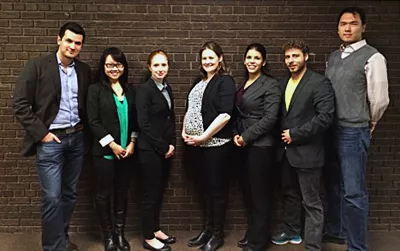
Life science course leads students from invention to invoicing
What do you get when you cross graduate life science students from U of T with engineers, IT students and OCAD U students? You get an innovative new course designed by Jayson Parker, a biotechnology lecturer at U of T Mississauga
Parker developed the Creating Life Science Products course through the Master of Biotechnology program because he “wanted to see students create a product idea they would pursue as a real business for their own employment.” In order to make this happen, there was a great deal of work creating partnerships and engaging programs across U of T and the GTA.
“There are some departments who saw the potential value in this course and readily supported its goals. Meeting with faculty to make sure they were comfortable with the course was also key,” says Parker. “OCAD University has played a major role in this course through their design students, and is part of our growing relationship.”
The BTC1850H course outline describes it as an interdisciplinary graduate course that focuses on a singular product problem. Projects can seek to enhance existing products or propose new products. Students in this course met twice monthly and rather than attend traditional lectures, they work on team exercises and discussion components, which help move the student projects forward. In many cases, the teams were forced to start on fresh ideas several times, with the goal of pitching to a panel of industry experts at the end of the course. The winning team received $3,000 donated by Burlington-based Boehringer Ingelheim Canada.
Dr. Theodore Witek, the past-president and CEO of Boehringer Ingelheim, was approached by Parker and quickly saw the benefit in supporting this initiative. Witek feels that many universities lack the practical application of theory, and this course provided the perfect opportunity for students to apply their knowledge and potentially make successful products that could lead to employment opportunities. “Great scientific and technical minds need to have an eye on business requirements to advance their ideas to health and happiness,” he says. “Invent yes, but also invoice.”
On April 7, six teams presented their product developments at the Ontario Investment and Trade Centre. The products ranged from hospital way-finding systems to improved taser design to custom lab coats.
The winning team developed a peanut allergy hygiene cream for surfaces that removes all traces of the allergen, leaving the surface safe for those with an allergy to peanuts. The members of this team felt their success was based on several factors: their academic diversity, that they worked well together, and that they were willing to put in the long hours required to create a new and effective product.
The students in this course came from a variety of backgrounds and the teams were able to draw upon the strengths of different students based on their key knowledge area. In fact, the winning team used a team-building exercise to determine each member’s strengths and weaknesses prior to the project to determine who would be best suited for individual tasks.
Parker feels that true success was not determined at the final case competition, but will be determined in the months and years ahead. “If the student product ideas, and the businesses created around them, grow into real companies with revenue and job creation then we will have success.”
